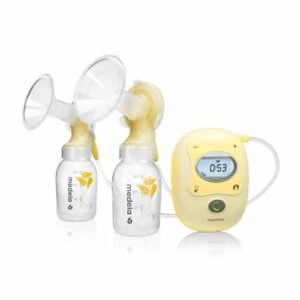To read the previous section, follow the link : Manual breast pump
If you’re struggling with milk production and you want to maintain or increase it, but you don’t want to operate a manual breast pump, or you want to pump faster with less effort during extraction, or you give the baby bottles very regularly (more than 3 to 4 per week), then choose an electric breast pump.
A single electric breast pump (one breast at a time) may be the solution if you want to express milk or give the baby bottles from time to time. This type of pump is not powerful enough to let you significantly maintain and increase the milk supply over the medium to long term. Again, the baby is responsible for maintaining the mother’s milk supply.
The advantages of a single electric breast pump:
It is quite compact and easy to operate. Mothers can regulate the suction rhythm and intensity. So, it is faster and less tiring for the moms than a manual breast pump.
The price:
The price is somewhere between $220 and $260.
 The double electric breast pump (pumps both breasts at once) is designed to maintain or build a mother’s milk production. As a result, it takes less time to extract the milk: between 10 and 15 minutes. Given the greater suction power, a mom can expect to express more milk than with a single electric breast pump. The resulting breast stimulation can mimic a baby’s sucking action to some extent. A double electric breast pump generates a faster, shallower rhythm of 100 to 120 cycles (suction and relaxation) per minute, followed by an ampler, deeper expression phase of about 60 cycles per minute with adjustable intensity. New moms appreciate this additional feature.
The double electric breast pump (pumps both breasts at once) is designed to maintain or build a mother’s milk production. As a result, it takes less time to extract the milk: between 10 and 15 minutes. Given the greater suction power, a mom can expect to express more milk than with a single electric breast pump. The resulting breast stimulation can mimic a baby’s sucking action to some extent. A double electric breast pump generates a faster, shallower rhythm of 100 to 120 cycles (suction and relaxation) per minute, followed by an ampler, deeper expression phase of about 60 cycles per minute with adjustable intensity. New moms appreciate this additional feature.
The advantages of the double electric breast pump:
The double electric breast pump also makes it possible to get to milk deeper in the mom’s breast. This increases the quality of breast drainage with milk of a higher caloric content for the baby and helps at the same time to maintain the production. But a note of caution: if the suction is too strong or the cycles are too long, your nipples may be injured.
There is a practical side, too. For example, a mom who has given birth to twins has her days full. So she needs better stimulation to adjust to her babies’ rhythm. A double breast pump lets her cut in half the time required for stimulation and extraction (which should never exceed 20 to 30 minutes).
Premature babies with a weak suck won’t stimulate their moms as much as full‑term babies with a very strong suck. In this case, a double electric breast pump allows users to replace or complement the baby’s breastfeeding for a while and stimulates the mother’s breasts to produce more milk for her baby.
Some mothers can’t imagine themselves breastfeeding but still want to give their milk to their baby. So this kind of breast pump is necessary because the baby is not providing the stimulation to keep up the supply. Some double electric breast pumps are more compact and portable than others. They may also be more functional, lighter, and more powerful. Thanks to the latest technology, there are pumps with rechargeable lithium batteries (as in cellular phones), programmable memory, hands‑free options and backlit digital displays. Everything technophile parents could possibly desire ha, ha, ha!
The price:
Of course, products that offer a variety of options also carry a higher price tag. For a double electric breast pump, expect to pay between $350 and $550, depending on portability and suction strength. Think about this: if you don’t breastfeed and you don’t express your milk, formula will cost you more in the long run than buying a breast pump and formula is less suitable for your baby. You may also consider that the purchase of a breast pump is an investment for the future if you have another child.
Maintenance:
You should follow the manufacturer’s directions because every model has its particularities.
To access the next section, click on the following link : Hospital-grade electric breast pump (rental)




